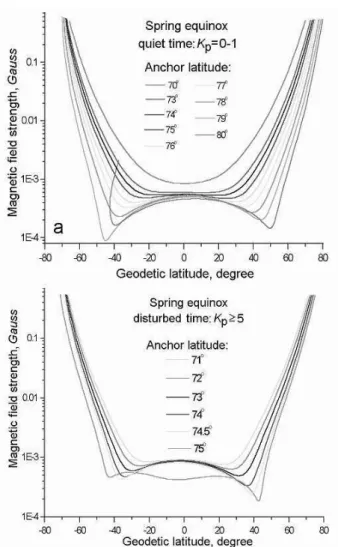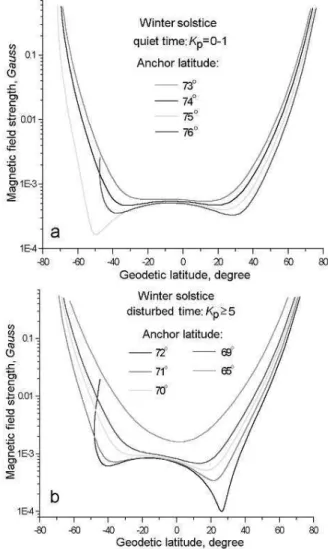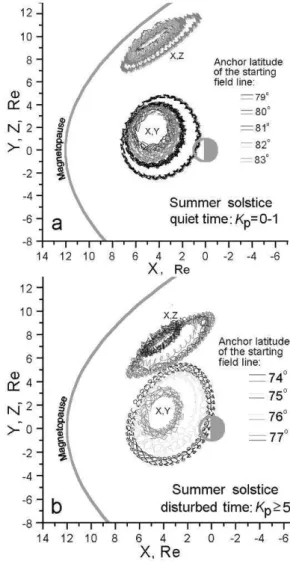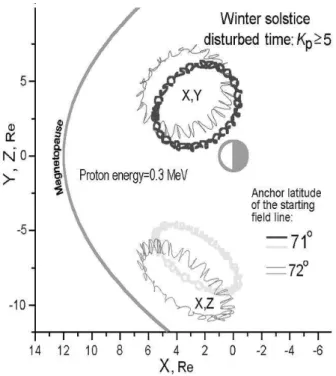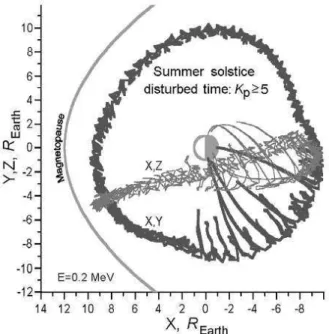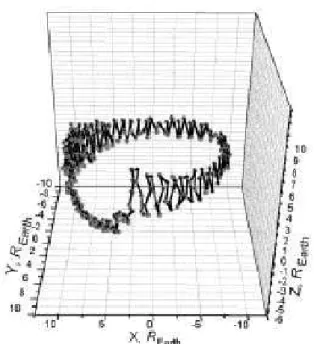Seasonal Cusp Radiation Belt on Dayside Magnetosphere
G.I. Pugacheva
1A.A. Gusev
2,3
U.B. Jayanthi
2, N.J. Schuch
1, and K.T. Choque
2 1Unidade Regional Sul de Pesquisas Espaciais/INPE, Santa Maria, Brasil
2
Instituto Nacional de Pesquisas Espaciais, INPE, S ˜ao Jose dos Campos, Brasil
3
Space Research Institute of Russian Academy of Science, Moscow, Russia
Received on 27 February, 2004; revised version received on 6 April, 2004
The possibility of quasi-stable trapping of charged particles of hundreds keV to MeV energy on the frontside Earth magnetosphere is explored in by numerical modeling of the single particle orbits in the geomagnetic field utilizing empirical Tsyganenko magnetic field model. Due to solar wind pressure the remote magnetic field lines on the frontside of the magnetosphere exhibit two minima in the geomagnetic field strength along the field line in high latitudes on the both sides of the equator. These minima may result in stable confinement structures, a kind of radiation belts, in the northern or/and the southern hemispheres, providing energetic particle trapping for times from several minutes to duration of seasonal scale. Simulation of energetic proton orbits passing through the regions of the magnetic field minima with different disturbance level and the Earth’s tilt reveals conditions in which these trapped radiation zones could result. It is shown that the existence of the adiabatic confinement zones strongly depends on the seasonal inclination of the Earth’s rotation axis. As a result the northern cusp confinement zone appears only in a summer solstice and similarly the southern cusp capture zone appears only in a winter solstice. In equinox time the confinement zones exist in both hemispheres in the disturbed magnetospheric conditions, however, they are less pronounced. The zones are essentially restricted to the sunlit magnetosphere. They form a kind of cusp radiation ring/belt, where a proton drifts with a period of several minutes, conserving its1stand the2nd adiabatic invariants. The latitudinal width of the ring is very thin, about 2-5 latitudinal degrees. The proton orbits passing through the off-equatorial field minimum opposite to those cusp belts reveal another interesting effect: a bound of the geomagnetic equatorial plane on the day sector. These and other features of the confinement zones in the two minima off-equatorial magnetic field regions are discussed.
1
Introduction
The existence of a magnetic field line structures with two off-equatorial minima at the distance of∼10REarth(Fig. 1, see also Figs.2-4) is a well-known feature of the front side magnetosphere, experimentally confirmed by Zhou et al. [1].
The importance of these structures for formation of trap-ped particle population in the distant magnetosphere was first time considered by Antonova and Shabansky [2] using a simple two-dipole approximation. They noted that a magne-tic field strength maximum between the two off-equatorial minima serves as a bifurcation point (branching point) for trajectories of some trapped particle drifting around the Earth from nightside. As a result a particle drift shell is re-presented with a double-connected surface, i.e. possessing a hole on its dayside. Roederer [1969][3] basing on Mead-Williams model [4] accounting magnetospheric tail current found even two bifurcation points related to three minima and two maxima at the subsol meridian.
Later it was noted that a local minimum existing on the dayside megnetic field lines could also exist on the lines bent from the Sun to nightside. If this local minimum exists around the cusp axis then, a confinement zone different from the classical radiation belt zone could be formed there, i.e. another kind radiation belts could exist with radiation loca-ted not around the Earth, along the geomagnetic equator, but
around the cusp regions only. Antonova et. al. [5] studied analytically some properties of such a trap using a simple axially symmetric magnetic field model for the cusp vici-nity.
The local minima in the cusp region are a direct result of the solar wind interaction with the magnetosphere and cusp parameters are controlled by the solar activity. On the other hand the cusp location and parameters strongly depend on the tilt i.e. the angle between Sun-Earth direction and the Earth’s magnetic dipole axis.
Until now the only attempt to study the influence of the tilt value on the cusp local minimum in the magnetic field strength (and consequently on formation of cusp radiation belts) was made by Shabansky [6] more than 30 years ago. Basing on a two-dipole model he found that the field mini-mum becomes less pronounced with a tilt increase and prac-tically disappear at the tilt of about 90◦, that occurs when
Figure 1. Magnetic field lines simulated with Tsyganenko-89 with the 90◦tilt in the noon meridian plane. Black solid lines depict
magnetic field lines with additional local minima. Grey lines show contours of the magnetic field magnitude (a factor 2 separates each contour).
2
The dayside magnetic field line
to-pology
We analyzed the dayside geomagnetic field line topology at three special time periods characterized by inclination of the Earth’s rotation axis to the Sun direction: summer and win-ter solstices (traditionally, for northern hemisphere) and the spring equinox. The tilt is in the range of 55.5◦-77◦in the
summer solstice; 79◦-101◦in the equinox, and of 102◦124◦
in the winter solstice. The tilt reaches the minimum value T = 55.5◦ in a summer solstice at U T = 17 : 30, when
the geomagnetic dipole axis is maximally inclined to the Sun-Earth direction. The tilt maximum value takes place in a winter solstice at U T = 03 : 30, when T = 124◦
and the Earth’s rotation axis is maximally declined from the Sun. The intermediate position corresponds toT = 90◦in
a spring equinox atU T = 11 : 30, when the Earth’s axis is perpendicular to Sun-Earth direction. The building of the lines is done utilizing the test code provided in Tsyganenko [7] model package. Figs. 2 a,b depict the magnetic field strength versus the geodetic latitudes along the dayside field lines of Greenwich meridian for the spring equinox for quiet
Figure 2. The geomagnetic field strength along dayside field lines versus geographic latitudes for the lines anchored at different la-titudes for equinox time: a) in the quiet magnetosphere; b) in the disturbed magnetosphere.
and active times of magnetosphere characterized in the mo-del by index IOPT. The field lines are traced for minimal (Kp= 1−2) and maximal (Kp≥5) levels of geomagnetic activity. They correspond to extreme values of the parame-ter IOPT, characparame-terizing geomagnetic activity in the Tsyga-nenko model: 1 and 8 respectively.
Figures show an existence of two off-equatorial minima in the field strength magnitude, both at quite and active ti-mes during the equinox time. The lines are traced from vari-ous latitudes from the Earth’s surface. The line anchored at the lowest latitudes exhibits only one traditional field mini-mum at the regular equatorial plane at quiet times (Fig. 2a, Lat.= 70◦). Maximal latitude corresponds the last closed
dayside line. Lines anchored at higher latitudes go out to the tail. The local maximum and adjacent minima are located on the lines anchored between 73◦ and 80◦ of geodetic
latitu-des during quiet magnetosphere in equinox time (Fig. 2a). The magnetic field strength in the deepest minimum reaches ≈10−4
Gs for latitude of 80◦. When the solar wind
pres-sure is increased (Fig. 2b) the two minima structure shifts inwards the magnetosphere placing between 71◦and 75◦
Figure 3. The geomagnetic field strength along dayside field lines versus geographic latitudes for the lines anchored at different lati-tudes for a summer solstice period: a) in the quiet magnetosphere; b) in the disturbed magnetosphere magnetosphere.
75◦(Fig. 2b) exhibits three local minima with related two
lo-cal maxims as is was predicted in [3] on the base of Mead-Williams model. The picture for an autumn equinox does not differ significantly from the spring equinox one.
The similar topology of magnetic field line with two off-equatorial minima exists during the summer (Figs. 3 a,b) and the winter (Figs. 4 a,b) solstices. As it could be expected, when the tilt differs from 90◦the picture becomes less
sym-metric. Fig. 3a demonstrates that during summer solstice the south minima (negative latitudes) broadens significantly be-coming less pronounced. The picture becomes more sym-metric with increased geomagnetic activity (Fig. 3b) exhi-biting again two distinct minima in the both hemispheres. Noticeably different behavior can be observed during a win-ter solstice (Fig. 4). Increased geomagnetic activity results in mirroring southern and northern branches of the structure with slight deepening of the northern field minimum.
The topology with two distinguished minima in the field strength is also found at all meridians from 0◦to 360◦when
they are exposed to the dayside, i.e. during the 24 hours of the day. Thus the two minima structure exists for any tilt both in quiet and disturbed condition. This result differs from that for the two-dipole model, where it exists only for a tilt range reduced to90◦− ±11◦[6].
Figure 4. The geomagnetic field strength along dayside field lines versus geographic latitudes for the lines anchored at different lati-tudes for a winter solstice: a) in the quiet magnetosphere; b) in the disturbed magnetosphere.
Each one of two distinct field minima could cause the lo-cal magnetic trap in the both hemispheres exactly the same way as one local field strength minimum of the deeper geo-magnetic lines which is situated in the geogeo-magnetic equato-rial plane causes the powerful and dangerous phenomenon of the Earth’s radiation belts. Does it mean that at the distant magnetosphere somewhere in high latitudes there exist two radiation belts analogous to the traditional radiation belts lo-cated in the geomagnetic equator (when a bounce motion of radiation belt particles is neglected)?
3
Particle motion in geomagnetic and
geoelectric fields
1/cm s in the belt maximum atL ∼ 1.5. This flux could impact a lethal doze on a human being in this place during several minutes.
If a charged particle passing along the field minima of Figs. 2-4 has closed trajectory (i.e. it returns to the same point where it starts), then it could mean that the particle could be trapped in the region. The method of a single charged particle orbit tracing is a commonly used method to analyze topology of the capture regions and has another useful applications.
Traditionally, a single charged particle transport in mag-netosphere is simulated by the guiding center motion of equatorially mirroring particles with the second adiabatic invariant vanishing (i.e. J = 0). Instead of this approxi-mation, the alternative, the particle orbit simulations based on the numerical solution of the full Lorentz force equation (Eq. (1)) for a particle motion in geomagnetic and geoelec-tric fields [8] is utilized here. The equation for a charged particle trajectory in the magnetic field of strengthBand in an electric field of strengthEis described as
d(mV)
dt =q µ
E+1
cV ×B ¶
, (1)
whereq,m, andV are particle charge, relativistic mass, and velocity andcis the light velocity. In a simple dipolar geo-magnetic field, in the absence of any electric fields, particles drift around the Earth due to the geomagnetic field gradient with the trajectories forming concentric circles around the dipole center. But in the presence of even small electric fi-eld in the morning-evening direction, charged particles drift inE×Bdirection from the night side towards noon
inde-pendent of the sign of their electric charge.
Eq. (1) is solved numerically applying the Runge-Kutta-Guills method. A corresponding Fortran code uses double and where necessary quadruple precision. The solution of the equation for the geomagnetic field has a form of auto control whereby charged particles drift around the Earth conserving the L-shell parameter, and after one drift period approximately return to the initial starting point, i.e. per-form a finite motion. In this case it is not necessary to check the solution by computing the reversed trajectory, utilizing methods employed in the calculation of arrival directions of particles from infinity such as cosmic rays reaching neutron monitors, etc.
the potential equal to that at the point of field line crossing geomagnetic equatorial plane. Tracing the potential along the neighboring lines, one can compute the electric field vec-tor asE=−grad U. We do not detail these calculations be-cause further we analyze the orbits of protons with energies great enough (0.1-several MeV) such that they drift prima-rily because of gradient-B rather thanE×Beffects. For the
geomagnetic field we use the Tsyganenko field model [7].
4
Confinement zones of trapped
radi-ation in the cusp region
Finding the field minima in chapter 2 we intend to search, if these minima indeed correspond some closed confinement zones which existence was predicted by Shabansky & Anto-nova’s theory. Our task is to study the characteristic features of these zones, utilizing the reliable empirical geomagnetic tilted field model of Tsyganenko [7]. It is important feature of our modeling differently from the modeling of the sin-gle charged particle orbits performed by Ozturk et al. [12], who used a more simple dipolar geomagnetic field model with an additional shifted dipole providing magnetic field compression in the dayside magnetosphere. It is also dif-ferent from the analogous modeling by Delcourt & Sauvad [13, 14], who did not consider an influence of geomagne-tic axis inclination to the Sun-Earth direction on the pargeomagne-ticle capture. The interest is to know if there exist particle closed orbits passing through that minima and as a consequence of it there exists particle traps there and if they exist what are the morphological and confinement details of the population in these regions at quite and disturbed conditions.
We examined these by simulating the orbits of protons within energies of 0.1 to 2 MeV starting from the point cor-responding to the northern minimum of each field line of Figs. 2 a,b for spring equinox time, of Figs. 3 a,b for sum-mer solstice, of Figs. 4 a,b for winter solstice with condition
(V·B) =0when the proton velocity vector is
perpendicu-lar to the magnetic field vector and proton does not almost oscillate between mirror points.
lat-Figure 5. 3-dimensional image of the 0.3 MeV proton drift or-bit passing along the northern field line minimum in summer sols-tice in the disturbed magnetosphere (Fig. 3b, anchor latitude 75◦).
The lower orbit (deflection) belongs to proton passing through the southern field minimum.
itude 75◦) confirming the possibility of existence of the cusp
radiation belt. Fig. 6 shows the projections of the drift tra-jectories of protons trapped during summer solstice in the northern minimum for quiet and disturbed times. They are finite, circular concentric trajectories along the minima as-sociated with the field lines connected to 74◦and 78◦
latitu-des of the Greenwich meridian in disturbed magnetosphere and to 79◦-83◦latitudes in quiet one. They keep pitch-angle
essentially near 90◦ withJ = 0conserved. They occupy
the sub polar, cusp region in a form of a plain belt, or a ring. Their one drift period around cusp region is about se-veral minutes and the particles could drift for many orbits within the belt accumulating flux until some dynamical pro-cess (there are many in the polar region) precipitate them from these stable orbits. It is a confinement zone of energe-tic charged parenerge-ticle radiation in the cusp region which could be named a cusp radiation belt of the Earth, or a cusp ring.
During quiet time the belt belongs to more distant field lines. As in disturbed conditions, its width spreads to about 5 latitudinal degrees. When another meridian, another mag-netic field line exposes to the Sun direction (i.e. the whole range of the tilt values was checked), the cusp ring/belt still exists with the similar topology only changing its position in geodetic coordinates. In summer solstice this polar belt ap-pears only in the northern hemisphere (Fig. 5). The protons having their orbits in the southern hemisphere minimum es-tablished on the basis of the same condition ofV·B=0do
not create confinement zone around the southern cusp (see Fig. 5, curve ‘deflection’), as it will be shown in the next chapter.
Figure 7 demonstrates the similar confinement zone structure with the radiation belt around the southern cusp in winter solstice during active magnetosphere. The northern cusp belt at the same time is absent. During spring equinox in disturbed magnetosphere there appear two cusp confine-ment zones (Fig. 8) where the energetic protons orbiting in both northern and southern off-equatorial field minima are captured.
Figure 6. The X,Y and X,Z projections in geodetic coordinates of the 0.3 MeV proton drift orbits passing along the northern field line minimum of Fig. 3 with zero2ndadiabatic invariant in summer
solstice: a) in quiet magnetosphere; b) in disturbed magnetosphere.
The protons with the energy up to 2 MeV could be trap-ped in such kind cusp belts: the 2 MeV proton orbits remain closed (Fig. 9), while the proton, for example, of 3 MeV energy escapes out of the trap to infinity.
Figure 7. The X,Y and X,Z projections in geodetic coordinates of the 0.3 MeV proton drift orbits passing along the southern field line minimum of Fig. 4 during winter solstice in disturbed magne-tosphere.
Figure 8. The X,Y and X,Z projections in geodetic coordinates of the 0.3 MeV proton drift orbits passing along the northern and southern field line minima of of Fig. 2 in apring equinox time in disturbed magnetosphere.
Figure 9. The X,Y and X,Z projections in geodetic coordinates of the 2 MeV proton drift orbit started in the northern field line strength minimum of Fig. 3.
5
Deflection of geomagnetic
equato-rial plane
The behavior of the protons during summer solstice showed the possibility of confinement in high latitudes along the northern off-equatorial field minima. Further we studied what happens with the hundreds keV protons starting their orbits from the opposite off-equatorial field minima in the southern hemisphere, with a pitch-angle of 90o. The re-sults for a summer solstice at L-shells of 8-9 are shown in Fig. 10 and 3-dimensional image of this orbit is shown in Fig. 5 (curve “deflection”). The protons are not orbiting in the confinement zone around the southern cusp as it could be expected analogously to its northern hemisphere’s behavior; they drift around the whole Earth.
On the night side all the orbits reside in the common geomagnetic equatorial plane. Entering evening side, they climb to higher latitudes reaching a peak on the noon side. Further on the dawn side they again descend to lower latitu-des such that its orbit remains in the same plane, inclined to geomagnetic equatorial plane and further on the night side they return to the geomagnetic equatorial plane (Fig. 10). The trajectory looks like belonging to an incurved plane whose dayside part deflected from the geomagnetic equator plane at the angle dependent on geomagnetic activity index Kp. The protons conserve their second invariant and pitch-angle near 904◦. This geomagnetic plane deflection occurs
Figure 10. The X,Y and X,Z projections in geodetic coordinates of the proton drift orbits starting from the southern off-equatorial field minimum of Fig. 3 atL∼= 8−9, conserving zero2nd
adia-batic invariant in quiet and disturbed magnetosphere and showing a deflection of geomagnetic equatorial drift plane.
While the protons orbiting at L-shells of about 8-9 con-serve their second invariant, for the particles drifting at gre-ater L-shells (L∼10−12), the second invariant is violated, as shown in Figs. 11 and 12. The invariant suffers strong variations on the night side and after one drift period proton “forgets” its initial2nd
invariant returning to the start point with the invariant significantly changed. It implies that par-ticles could not be trapped on such orbits for more than 2-3 drift rotations and should be considered as quasi-trapped. This effect first time was considered by Shabanskiy [6] and Antonova et al. [15].
Figure 11. The X,Y and X,Z projections in geodetic coordinates of the proton drift orbits starting from the southern off-equatorial field minimum of Fig. 3 atL ∼= 10−12showing a violation of 2ndadiabatic invariant.
Figure 12. The variations of the proton 2ndadiabatic invariant along the orbit shown in Fig. 11.
In an equinox time the both cusp local belts exist only in the disturbed magnetosphere. At quiet time, a proton star-ting along the northern field minimum on the dayside sector drifts in a plane perpendicular to the geomagnetic equato-rial plane. On the morning side its motion gets a character of regular drift in the geomagnetic equatorial plane, retur-ning after passing the nigth sector and the everetur-ning lobe to the starting point in the same plane perpendicular to mag-netic equator on the midday sector (Fig. 13). Similar orbits are shown for particles starting in the southern minimum at midday sector in quiet magnetosphere (3-dimensional orbit image in Fig. 14). These kind of trajectories were also pre-dicted by Shabanskiy [1971] and was studied by Delcourt et al. [13, 14] and Ozturk et al.[12] using different magnetic field models.
Figure 14. 3D image of proton orbit starting from the southern off-equatorial field minimum of Fig. 2 in equinox in quiet magne-tosphere.
6
Conclusion
Numerical simulation of energetic proton orbits in the em-pirical magnetic field model of Tsyganenko shows the exis-tence of the confinement zones in the cusp region of the Earth magnetosphere. The remote magnetic field lines com-pressed by the solar wind on the frontside magnetosphere possess two off-equatorial field minima in the northern and in the southern hemispheres that provides in determined conditions relatively stable magnetic trap. The zones form a kind of cusp radiation ring/belt, they are very thin in latitude units (several latitudinal degrees). Energetic protons may be temporarily trapped there for times from several minutes to days. This possibility depends on the seasonal tilt of the Earth’s magnetic dipole axis. The energetic protons could be relatively stably captured within the northern cusp radi-ation zone at summer solstice and within the southern cusp at winter solstice. In equinox time the confinement zones exist in both hemispheres during disturbed magnetosphere, however they are weak, less pronounced. While at solstices one off-equatorial minimum region contains the cusp trap-ped radiation, another off-equatorial field minimum shows one more noticeable feature in disturbed magnetosphere: a
[1] X.-W. Zhou, C. T. Russel, G. Le, and N. Tsyganenko, Ge-ophys. Res. Lett.24, 1451 (1997).
[2] A. Ye. Antonova, and V. P. Shabanskiy, Geomagnetism e Ae-ronomia,8, 639 (1968)
[3] J. G. Roederer, Rev. Geophys.7, 77 (1969).
[4] D. J. Wilhams, and G. D. Mead, J. Geophys. Res.70, .3017 (1965).
[5] A.Ye. Antonova, Y. I. Gubar, and A.P. Kropotkin, Geomag-netism and Aeronomy,41, 6 (2001).
[6] V. P. Shabanskiy, Space Sci. Rev.12, 299 (1971). [7] N. A. Tsyganenko, Planet. Space Sci.37, 5 (1989).
[8] A. A. Gusev, and G. I. Pugacheva, Geomagnetism and Aero-nomia (in Russian),22, 487 (1982).
[9] G. I. Pugacheva, U. B. Jayanthi, N. G. Schuch, A. A. Gusev, and W. N. Spjeldvik, Adv. Sp. Res.32, 2240 (2004). [10] J. G. Roederer,Dynamics of Geomagnetically Trapped
Radi-ation, Springer-Verlag, Heidelberg-New York, (1970). [11] H. Volland, J. Geophys. Res.83, 2695 (1978).
[12] M. K. ¨Ozt¨urk, A. A. Chan, and R. A. Wolf, Violation of the Second Invariant in a Static Magnetic Field, 10 International Workshop ISEC 2001: Radiation Belt Science and Techno-logy, Queenstown, New Zealand, (2001).
[13] D. C. Delcourt, and J.-A. Sauvaud, J. Geophys. Res,103, (A11), 26521 (1998).
[14] D. C. Delcourt, and J.-A. Sauvaud, J. Geophys. Res,104, (A10), 22635 (1999).
